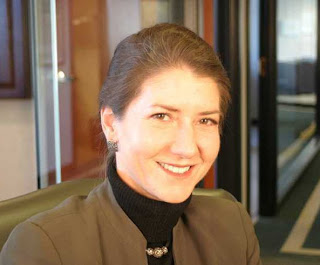 The nation's leading economics bloggers have a
more balanced outlook than last quarter, according to a new Ewing Marion
Kauffman Foundation survey released today. Anticipating positive
movement in the gross domestic product and other key indicators, 59
percent of economics bloggers who responded to
the second Kauffman
Economic Outlook: A Quarterly Survey of Leading Economics Bloggers
described the economy's overall condition as "mixed," with the rest
evenly split between positive and negative assessments.
The nation's leading economics bloggers have a
more balanced outlook than last quarter, according to a new Ewing Marion
Kauffman Foundation survey released today. Anticipating positive
movement in the gross domestic product and other key indicators, 59
percent of economics bloggers who responded to
the second Kauffman
Economic Outlook: A Quarterly Survey of Leading Economics Bloggers
described the economy's overall condition as "mixed," with the rest
evenly split between positive and negative assessments.
The Outlook report also features questions from five economics bloggers on issues ranging from the long-range U.S. budget outlook to the future viability of China's economy. Respondents answered questions posed by Tyler Cowen, Marginal Revolution; Ken Houghton, Angry Bear; Arnold Kling, EconLog; Mark Perry, Carpe Diem; and Mark Thoma, Economist's View.

 As the U.S. President and Congress desperately search for ways to
regain the
As the U.S. President and Congress desperately search for ways to
regain the  When
When 
 Bill Harding: Some people like fundraising. I'm not
one of them. Running a profitable company for the past year has afforded
me the luxury to wake up every morning and say to my mirror: “What
would you most like to do today, you cunning devil, you?”
Bill Harding: Some people like fundraising. I'm not
one of them. Running a profitable company for the past year has afforded
me the luxury to wake up every morning and say to my mirror: “What
would you most like to do today, you cunning devil, you?” The National Association of Seed and Venture Funds (NASVF) and the Temple University Fox School of Business announced today that the percentage of venture and angel funds focused on investing in seed stage companies has increased 40% from 2009 based on the second annual survey to its members.
The National Association of Seed and Venture Funds (NASVF) and the Temple University Fox School of Business announced today that the percentage of venture and angel funds focused on investing in seed stage companies has increased 40% from 2009 based on the second annual survey to its members. “The speed of turnaround in the situation is truly impressive. It shows the overall pick-up in the confidence that fund managers seem to have in seed stage companies” said Raj Chaganti, professor in Entrepreneurship and Strategy at the Fox School of Business.
“The speed of turnaround in the situation is truly impressive. It shows the overall pick-up in the confidence that fund managers seem to have in seed stage companies” said Raj Chaganti, professor in Entrepreneurship and Strategy at the Fox School of Business. In the 7 May 2010 issue of Science,
In the 7 May 2010 issue of Science,  Health care and the economy rank among today's most dynamic and important conversations taking place in Iowa and across the nation. While viewpoints vary, in each case Americans are eager for solutions that improve the lives of their families and strengthen their communities. Looking to the future, we all can rally behind a common link that supports recovery from both a wellness and fiscal standpoint: medical innovation.
Health care and the economy rank among today's most dynamic and important conversations taking place in Iowa and across the nation. While viewpoints vary, in each case Americans are eager for solutions that improve the lives of their families and strengthen their communities. Looking to the future, we all can rally behind a common link that supports recovery from both a wellness and fiscal standpoint: medical innovation. Business incorporation has become synonymous with responsible business ownership. Yet, so many misconceptions and rumors exist about the benefits of business incorporation. So it’s no wonder that even the savviest entrepreneurs are at a loss as to whether incorporation is right for them, what it will cost, and where to start.
Business incorporation has become synonymous with responsible business ownership. Yet, so many misconceptions and rumors exist about the benefits of business incorporation. So it’s no wonder that even the savviest entrepreneurs are at a loss as to whether incorporation is right for them, what it will cost, and where to start.
 How do you keep ideas flowing? How do you create a wealth of ideas to choose from? How do you make sure you get to the one killer idea that will make your advert, novel, article or blog post really stand out from the rest?
How do you keep ideas flowing? How do you create a wealth of ideas to choose from? How do you make sure you get to the one killer idea that will make your advert, novel, article or blog post really stand out from the rest?

 Here’s a really terrific
Here’s a really terrific 
 Mark Heesen, who leads the venture industry’s main lobbying group, said today that there have been pluses and minuses about President Obama’s approach to regulation and taxes. Heesen said the federal government is considering some anti-venture legislation, but he sounded pretty confident that most of it won’t get passed.
Mark Heesen, who leads the venture industry’s main lobbying group, said today that there have been pluses and minuses about President Obama’s approach to regulation and taxes. Heesen said the federal government is considering some anti-venture legislation, but he sounded pretty confident that most of it won’t get passed.
 A new program will help Wyoming inventors, entrepreneurs and companies get their ideas into the marketplace, allowing them to create technology and business ideas and then communicate those innovations on a national level.
A new program will help Wyoming inventors, entrepreneurs and companies get their ideas into the marketplace, allowing them to create technology and business ideas and then communicate those innovations on a national level.